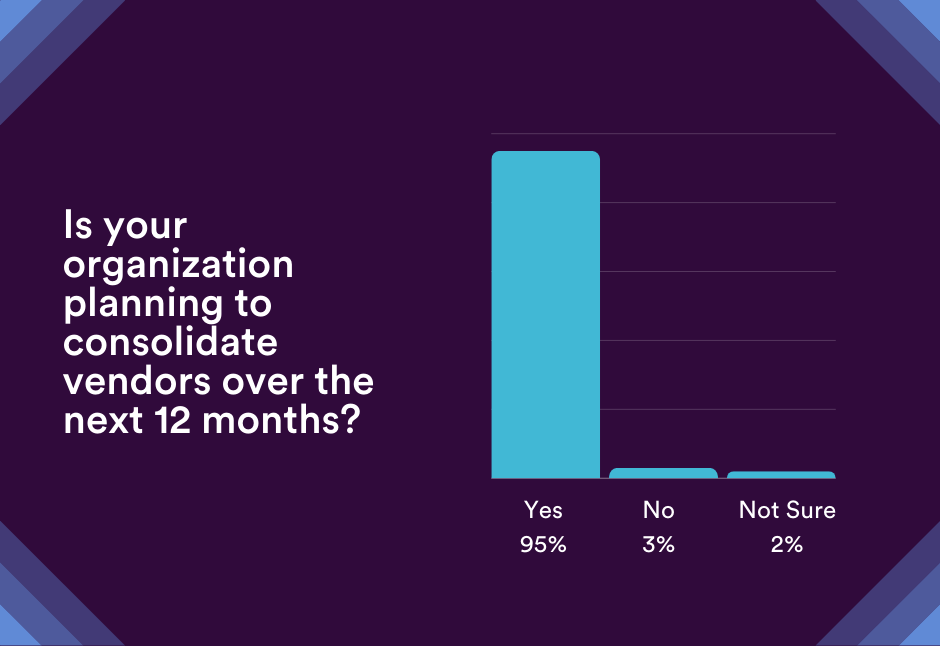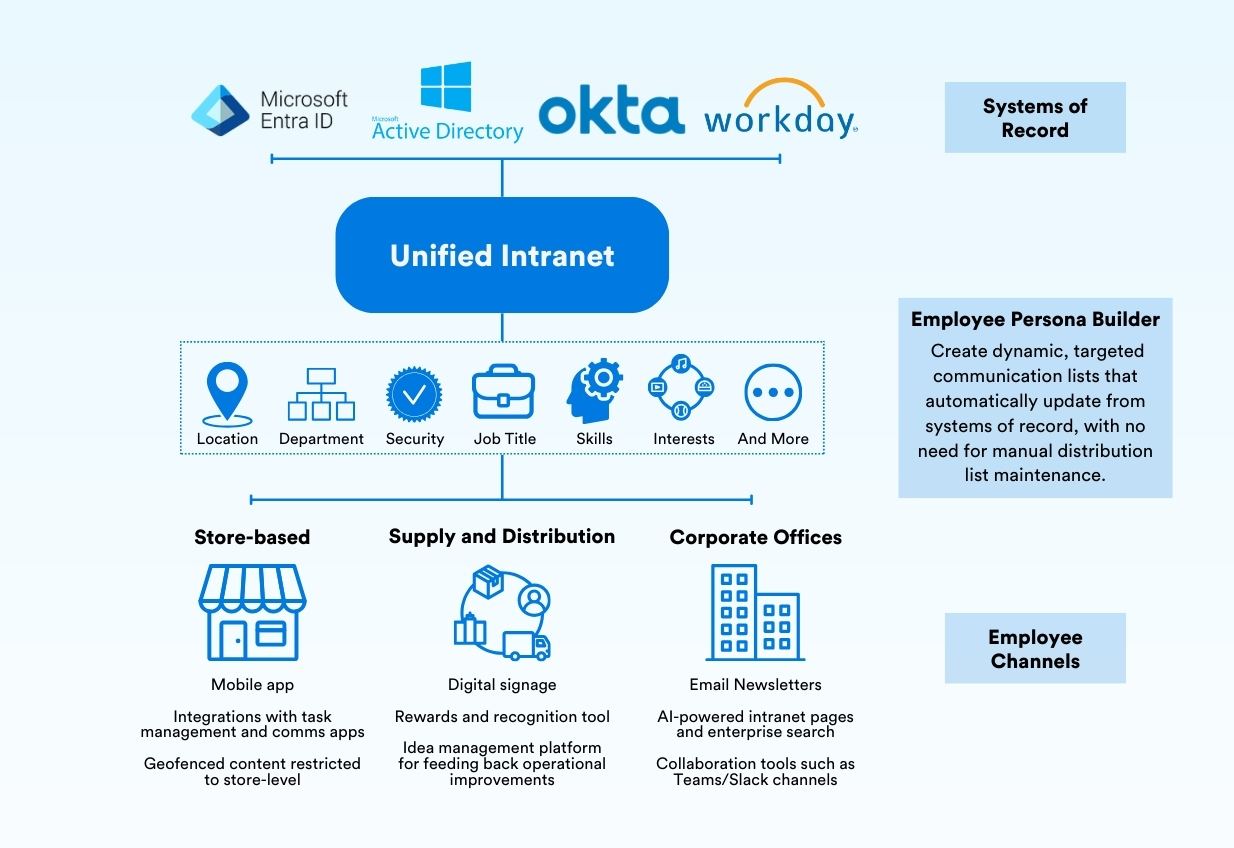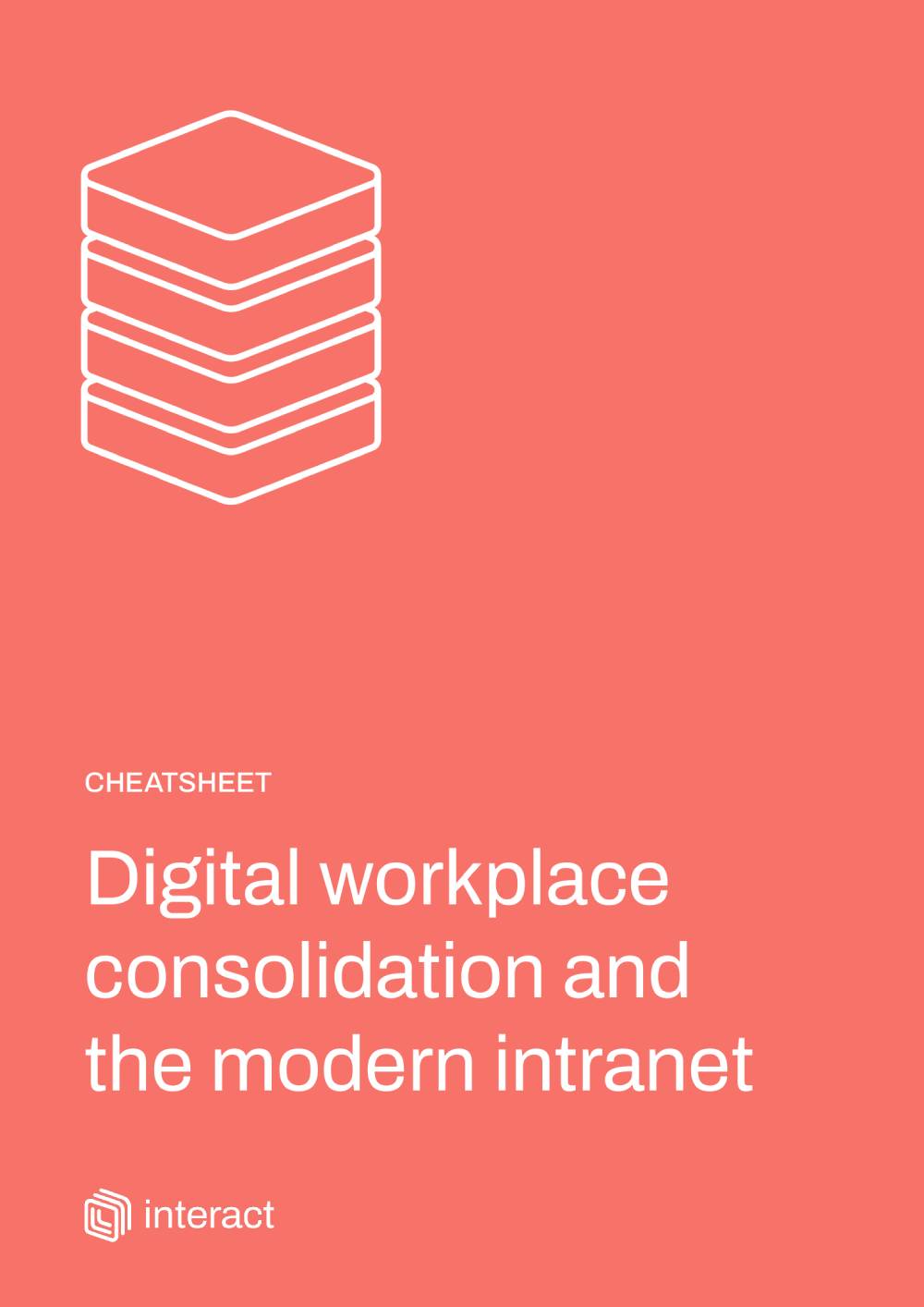Technology consolidation is a top priority for retailers right now, and for good reason. Streamlining solutions can transform employee experience, communication, and productivity. This article explains how retail technology consolidation can meet unique industry challenges, and how the right employee experience platform can help your organization make it happen.
With the volume of apps and software businesses use today, digital consolidation is a key strategy for every sector. For the retail industry, it has become a necessity to ensure employee engagement, retention, efficiency, and business success.
When it comes to engaging and disseminating information to employees, retail enterprises face several unique challenges, including high turnover rates, a large number of deskless workers, and an audience with widely varying roles and functions that is often distributed geographically. Retailers must be intentional about technology choices to create a unified company culture and a digital workplace that enables efficiency and strong performance.
Consolidation of technology solutions can help retail companies engage and support every employee while meeting business goals, but with the typical organization’s tech stack so overloaded, it can be difficult to know where to start. This article dives into the importance of retail technology consolidation and explains why adopting a unified, AI-powered employee experience intranet allows businesses to streamline their IT solutions.
Your roadmap to digital workplace consolidation
An industry grappling with digital overload
Currently, most retail organizations utilize a combination of solutions for communication, knowledge sharing, collaboration, task completion, and more, resulting in an overload of apps and platforms. A few examples of frequently used retail solutions include employee communication apps, digital signage, data analytics software, “shadow IT” technologies such as WhatsApp, and employee idea management software. One survey found that large enterprises have an average of 211 apps in use by employees.

Digital overload can be problematic for the entire retail organization, impacting all employees from cashiers to distribution staff to the C-suite. Staff who work in an environment with too many technology solutions may experience confusion – they aren’t always sure what app to use for what purpose, which website to visit to complete an HR task, or where to locate key policies and information. Retail employees often have to download apps on their personal devices, and the more solutions they’re required to use, the more resistant to software adoption they become. Communication can suffer as well. Employees may not receive key company updates because they’re unsure of where to look for them, and information can become siloed as deskless and desked workers gravitate to different platforms.
Internal comms, HR, and IT teams at retail enterprises all suffer from the effects of digital clutter. The lack of a single platform for communication and information hosting makes dispatching, tracking, and analyzing employee communications much more complicated. Having multiple independent solutions for functions such as onboarding, training, and employee recognition leads to duplicated work and wasted time. And with many different types of software to support, IT’s work multiplies.
A lack of retail technology consolidation can damage a company’s bottom line with the increased time and resources required to manage many different vendors, reduced operational efficiency, and even greater cybersecurity risks (each independent solution presents its own opportunity for a breach).

In response to these issues, retail enterprises are increasingly prioritizing technology consolidation. Research shows that 95% of organizations are planning for IT vendor consolidation in the next year, and over 90% of organizations are actively searching for a unified IT platform. This push to optimize technology is due not only to the drawbacks of utilizing too many solutions, but also to a need to adapt to the current landscape. In an industry where efficiency, reputation, and retention are paramount, enterprises that aren’t thinking about technology consolidation risk getting left behind by competitors. Retailers are facing pressure to reduce costs, optimize processes by harnessing Generative AI, and improve the employee experience. A powerful all-in-one solution that has the functionality to advance all of these goals at once is a win-win.
Your roadmap to digital workplace consolidation
Addressing challenges with retail technology consolidation
Every sector, from finance and franchise to healthcare and construction, has its challenges when it comes to tech consolidation. The retail industry grapples with several unique communication, employee experience, and operations factors, many of which can be addressed by consolidating retail technology into a single platform.
Organizations in the retail sector typically have a complex mix of employees working in corporate offices, regional locations, stores, and shipping. It can be difficult for centralized internal comms and HR teams to reach and engage a workforce with diverse personas and varying levels of access to digital devices and accounts.

Many (or most) retail employees do not have access to a computer, company-issued mobile device, or even a corporate email account, which forces corporate communicators to find alternative ways to connect with them.
Additional challenges that make retail technology consolidation a necessity include:
Turnover
Retail organizations typically experience high turnover rates due to workforce factors such as seasonal employment, part-time work, and entry-level positions. Constantly hiring and training new employees can create difficulties in maintaining consistent communication channels. Employees may miss important updates or training sessions, leading to gaps in knowledge and productivity.
A diverse audience
Retail businesses often employ a diverse workforce, including individuals of different ages, backgrounds, languages, and education levels. Communicating effectively with such a diverse group can be challenging, as messages may not resonate equally with all employees. Misunderstandings or misinterpretations of communication can occur, leading to confusion, disengagement, and decreased morale among employees.
Widespread locations and regions
Retailers operate multiple store locations or have remote employees working in different regions. Communicating with dispersed teams can be challenging. Information may not reach all employees in a timely manner, leading to inconsistency in messaging and alignment across the organization.
Retail technology consolidation can address the above issues by streamlining experiences for communicators, HR teams, and employees. Reducing the number of channels and platforms in use through the adoption of a single, all-encompassing employee experience solution can help retail companies better reach, engage, and inform their workforces.
Your roadmap to digital workplace consolidation
Consolidating retail technology with an employee experience platform
Retail businesses need clear communication and a streamlined employee experience, or they risk inefficiency, low engagement, decreased productivity, and increased turnover in an already high turnover environment. Having too many apps, platforms, and channels can cause several issues, including:
- An inability to consistently and effectively update all employees with the essential information they need to do their jobs, whether they’re working in offices, stores, or warehouses
- Frustration on the part of employees, who are overwhelmed by the number of solutions and channels they’re expected to use and lacking a go-to location for communication, information, and task completion
- Inefficiencies in internal communication, HR, and IT that stem from teams tasked with managing too many tools
Retail technology consolidation can solve these challenges, and a comprehensive employee experience intranet solution is an effective way to achieve it. Retailers will want to look for a platform that goes beyond the functionality of a traditional intranet to encompass employee experience and internal comms, and serve as a one-stop-shop for employee needs. The right solution can break down silos, keep communications consistent, improve staff experiences across a diverse and dispersed audience, and even boost ROI.

Using a high-quality employee experience intranet as part of a retail technology consolidation strategy can be transformative, especially considering the industry’s unique challenges and hard-to-engage workforce. The integrated communication, information management, and personalization that this type of platform can provide will help to create a better digital workplace, better employee experiences, and better overall performance.


